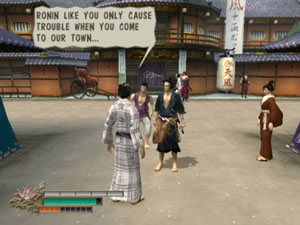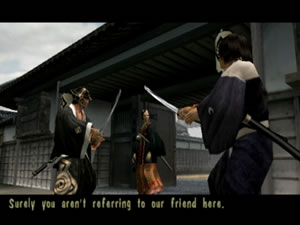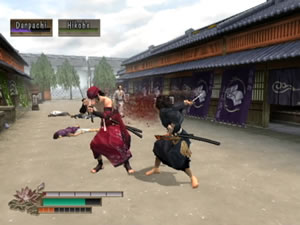Ronin on empty.
The Choose Your
Own Adventure series of the 1980s offered the perfect disguise for a
pre-teen boy trying to fool people into thinking he was actually reading a book.
They weren’t
gaudily oversized like D&D tomes, didn’t deal with “serious” subject matter like
Judy Blume books, and served up some decent fantasy-driven plots. Plus, you got
to call the shots, in a sense, which was a helluva lot more appealing than finding
out what
Margaret was asking God about. Yuck.
The concept was simple: as you read, you were offered choices. “Save the kitty and turn to page 110, or Murder the kitty and turn to page 109.” This allowed the sly authors to dish out some basic morality (if you murdered said kitty, you’d probably wind up eaten by a bear) while giving young readers the illusion that they were in control of their books.
But
while the re-readability of a Choose
Your Own Adventure book is part of the lure, that doesn’t mean this kind
of thing works as a game. If you don’t believe me, try spending a couple
days slogging through Way of the Samurai 2, a game long on quirky
design but painfully short on interesting gameplay.
The ancient Japanese town of Amahara is in the midst of a struggle between the
local magistrate and the drug-peddling Aoto gang. You play as a lonely, starving
samurai who just rolled in looking for some action. As it happens, a mute little
girl lends her support by feeding you, and from there, it’s off to uncover your boring destiny.
Amahara is broken up into ten small areas that you will explore over the course
of the ten in-game days you spend roaming about. Along the way, you will talk
to NPCs, make basic dialogue choices and pick up odd jobs for the magistrate,
Aoto gang or local townsfolk. Like a Choose
Your Own Adventure, each decision you make can affect the outcome, and based
on how it all plays out, you’ll either die or wind up seeing one of the game’s
various endings.
Here’s the rub: it only takes between one to three hours or so to complete the
cycle, so the whole point is to do it again and make different choices. Much
like Bill Murray in Groundhog
Day, you relive the exact same ten days over and over again, just without
the Sonny and Cher mornings. Say hello to repetition!
You start off each day getting fed by the mute girl, and then choose one of three
dialogue options to set yourself down a path. It doesn’t seem to matter if
you go left instead of right, however, because all roads eventually lead somewhere.
Sadly, poor translation errors make it a little hard to figure out how the
morality works, so making dialogue decisions largely boils down to trial and
error. Besides, you’ll be able to choose differently a few hours later when
you replay the exact same sequence again.
 The
The
ten areas are all very small and are only connected via an overhead map, so there
is no sense of geography or continuity at all, just a bunch of stand-alone boroughs
made up of two or three dusty streets at best. You’ll most certainly need to
take jobs to earn some cash, which can then be spent on basic health or energy
restoratives.
Way of the Samurai 2 clearly tries to paint itself as the gaming equivalent of Kurosawa’s classic Yojimbo, allowing you to play the three sides against one another as you earn money from each. Unfortunately, the jobs routinely suck. You’ll spend the first 5 or 6 days as an errand boy, simply going to an area, picking up a package and returning it to the employer. Though they eventually get more interesting and include actually killing people, keep in mind that every time you play the game and restart the ten days, you have to run the errands again. It’s maddeningly dull and seems like a massive waste of your skills as a samurai.
Those skills will be put to the test often enough, however, because you can attack
anyone at any point. Combat is reminiscent of the original Bushido
Blade in
that it’s
in full 3D and you can effectively run around instead of being forced to fight,
but that’s where the similarities end. There are about 60 different kinds of
swords in the game and each has a slightly different move list, which is cool,
but the fighting is ruined by a parry ability that completely overwhelms the
need to strategically swipe at your opponent. You just wait for them to attack,
press R1 and Left or Right, automatically knock them off balance and proceed
to do your best sushi chef imitation with the small of their back. When coupled
with the lack of any sort of decent enemy A.I., it effectively renders the
fighting almost pointless.
While it’s true that you can attack people at will, the game gives you a false sense of open-ended play. Attacking innocent townsfolk will result in every shop refusing to grant you entrance, effectively cutting off the ability to buy anything at all. But despite the fact that you might be working for the Aota gang and trying to be an evil samurai, the game will not allow you to kill or threaten shopkeepers or steal goods or really do anything bad at all; you’re merely not allowed in, end of story. It ruins the whole concept of living out the ten days as a bad guy.
 And
And
unlike a Choose
Your Own Adventure book, you cannot just skip to a specific story point,
make an alternate decision and see how it plays out. Rather, you start the whole
thing over again from the beginning and have to wade through cut-scenes, perhaps
spending 45 minutes following a path you’ve already taken just so you can make
a different decision at day 5. It’s like having to re-read the whole damn book
every time you want to turn to a different page. It’s enough to make you want
to Murder the proverbial kitty.
Still, Way of the Samurai 2 includes a few nice touches to encourage
repeated play. You can store swords or items in a safe, which can then be accessed
when you start over to better equip your samurai from the get go. A blacksmith
can upgrade swords to increase their quality, attack/defense power and durability,
lending a bit of depth. At the end of a gameplay session, you’ll get a samurai rating and a point reward, which unlocks extra outfits and faces
However, the overall look is so unimpressive, you’ll hardly care to change your clothes. The character models are often repeated and aren’t animated very well, while the cut scenes make the characters look like lifeless mannequins. Each small area is bland, mainly dirt roads and poorly textured buildings.
Where things really go astray, though, is in the terrible voice-acting. There
is no Japanese language option; it’s only English and it’s consistently awkward
and amateurish. The music is decent, at least, mostly harmless Japanese melodies.
You have to commend Way of the Samurai 2 for trying something
different, but its myriad design flaws, weak delivery and repetitive nature serve
as a reminder that different doesn’t necessarily mean fun. Choose
another adventure instead.
-
Lots of swords
-
Interesting concept
-
Which isn't interesting to play
-
Insanely repetitive
-
Bland graphics, terrible voices
-
Go read: "Your Code Name Is Jonah"











